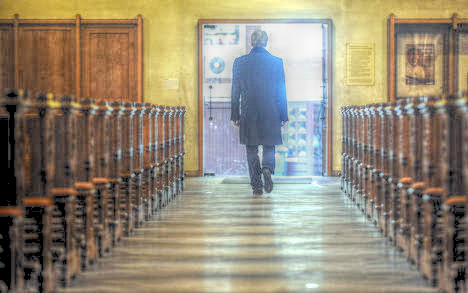
I’ve been thinking about the topic of churches recently. Horsa and those commenting on her article, “How to Suffer,” made some interesting related points about church membership. I recommend that everyone read the article and the comments that follow. I commend Horsa’s humility in admitting that it is possible to be too hasty to condemn others in our zeal for truth. I can attest from my own experience that she is right about that.
That aside, the main question in the article and comments is whether or not devout Christians who are pro-white and red-pilled on the Jewish Question should remain in their normie cucked churches.
Simply put: it depends.
Did you like that side-stepping of a point of contention? Well, it’s not actually an evasive maneuver. It’s the beginnings of a complex answer to a complex question.
In the Bible we are commanded to love Christ’s bride, of which we become a part when we confess Christ as Lord and Savior and are baptized. We are given plenty of instructions of what to do as part of and within the context of the Church.
Simultaneously in the Bible we are commanded to separate ourselves from apostasy and moral corruption in the Church.
Unfortunately in the Bible there’s not a very clear description of how individuals, families, congregations, or larger people groups are supposed to transition from being part of a corrupted Church to being part of (or forming) a more faithful, orthodox Church. It has been done historically, but to this day well-meaning Christians argue about how it should be done in order to not show disregard for Christ — Who established, organized, and is Head of the Church — or our brethren in Christ, many of whom may choose to not reform, separate, or work with us to establish a purer ecclesia.
Sometimes the Church has been reformed and purified from within, and the corrupt heretics have been pushed out of fellowship. This is what happened in the early Church when St. Athanasius and friends won back control of the Church when the Arians had seized power and held sway with the empire, allowing them to dominate and persecute Trinitarian Christians. (Arius taught that Christ was not the eternally existent second person of the Trinity. In his view Christ was merely a very exalted created being. Arius denied that Christ or the Holy Spirit were co-equal to the Father in terms of their divinity. The Jehovah’s Witnesses still teach this heresy.)
At other times the Church has been incapable of reformation and purification from within, and so after trying for years to accomplish what turned out to be impossible, faithful Christians have separated from the corrupt part of the Church in order to continue worshipping and evangelizing apart from those apostasies and moral errors. This is what happened during the Reformation when Luther, Calvin, and friends ultimately had to part ways with the Roman bishop because he and his clique (and the governments allied with them) would simply not reform in terms of doctrine, worship, or practice.
Both of these scenarios have played out many times, including in our lifetimes. Decades ago, the Southern Baptist Convention was moving in a steadfastly liberal direction. Thanks to the efforts of men like Adrian Rogers, that denomination was won back to scriptural inerrancy and other more conservative positions for many years. These days the SBC is slipping again into serious decline, but the point is that reforms from within have happened in our lifetimes. Similarly, faithful members of the mainline Protestant churches (Episcopalian, Presbyterian, Lutheran, etc.) have had to depart their church homes and form new denominations and congregations because their church leadership refused to repent of their heresies and moral errors.
Many times, reform movements within the Church have failed to achieve their goals, and those pushing for reforms have sat down and remained in their churches hoping that at some point someone would accomplish what they could not. The pre-Reformation era had many movements pushing for the same kind of moral (and even doctrinal) reforms that Luther and company later advocated. In the early days of American colonization, those desiring the purity of the English Church split over whether to stay or go. The small number of Pilgrims chose to go; the rest of the Puritans chose to stay. (The separatists left not only the English Church but also England itself, and came to America.) However, after banging their heads on that wall for another decade, many more Puritans eventually left as well. In the Roman Catholic world, the Society of St. Pius X has existed for decades in a gray space where it stands for pre-Vatican II policies in the midst of a post-Vatican II pontificate.
So in Church history we have examples of faithful Christians grappling with the question of how to deal with corruption and error — and they didn’t always take the same route.
We see that in every case the motive was love for Christ and His Church, and a desire to be a light to the unsaved.
We see that their motives notwithstanding, they couldn’t control the result. They all used the same means — prayer, petitions to the church leadership, and educating the broader clergy and laity about the issues at hand — but got different results. At the end of the day some of them were able to enjoy the fruits of an ecclesiastical reconquest. Most of them had to choose between spending the rest of their lives under heresy, immorality, and apostasy, or separating to freely worship Christ and remain faithful to His Word.
That is where we are. In a future article, we’ll look at tests or marks that previous generations of earnest Christians used to distinguish themselves from their heretical and apostate peers. In so doing we’ll be one step closer to determining whether and why staying, or separating, is the right thing to do for pro-white Christians today.
| Tweet |
|
|
|




